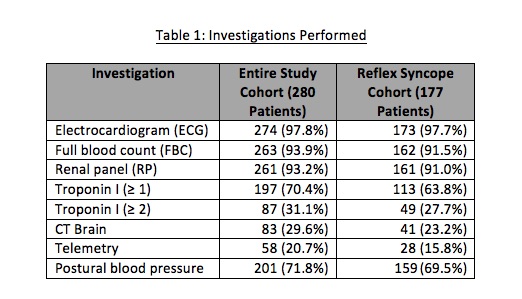Background: Syncope is a common presentation encountered by hospitals worldwide. While well-established guidelines exist, there is significant variation in practice regarding the investigation and management of these patients. Practitioners tend to over-investigate, which may lead to unnecessary hospitalizations, length of stay and cost.
In this study, we analyzed the utilization of healthcare resources for patients presenting with syncope to our hospital’s emergency department.
Methods: We reviewed the electronic medical records of all patients presenting to the emergency department with syncope from January to June 2018. Syncope cases were identified via ICD codes and verified by a manual audit of the electronic records. The mechanism of syncope was subsequently classified into reflex, cardiovascular or secondary to orthostatic hypotension. Data regarding investigations performed, hospitalizations and length of stay were extracted for analysis.
Results: 280 patients presented to the emergency department with syncope during the study period. 177 of 280 (63.2%) were classified as having reflex syncope, 37 of 280 (13.2%) as having syncope due to orthostatic hypotension, and 12 of 280 (4.3%) as having cardiac syncope. 54 of 280 (19.3%) had no identifiable cause after workup.
159 of 280 (56.8%) patients were admitted to the hospital, including 89 of 177 (50.3%) of patients who were eventually diagnosed with reflex syncope. The median length of stay was 3 days, amounting to 3.37 hospital beds per day over the 6-month study period.
The numbers of patients undergoing various investigations are summarized in Table 1 (attached). More than 93% had basic blood tests (full blood count and/or renal panel) performed. In contrast, only 201 of 280 (71.8%) had a postural blood pressure measurement documented. Among the patients who were eventually diagnosed with reflex syncope, the proportions undergoing various tests were similar.
Conclusions: Our study revealed a high rate of admission to hospital for patients presenting with syncope, even among those who were eventually diagnosed with reflex syncope. The vast majority of patients also underwent basic blood tests, a practice that is not recommended routinely in current guidelines.
Further research is needed to ascertain the key factors influencing admission and testing, in order to guide strategies to reduce unnecessary healthcare resource utilization.

